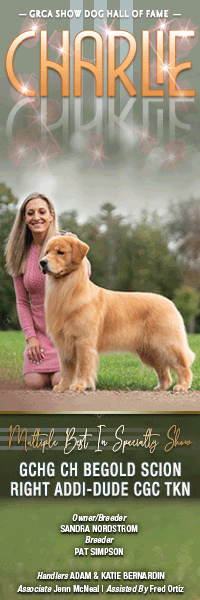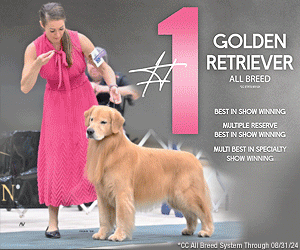When 23 and Me Has Gone to the Dogs
Click here to read the complete article
132 – September 2019
Has he been tested for DM?” Degenerative Myleopathy testing is the newest “gotta-have” DNA test in the dog world. And it’s the perfect example of genetic testing gone wrong.
That was one of the many messages from the 2019 AKC National Parent Club Canine Health Conference recently held in St. Louis. It was the 11th such conference (and the 10th I’ve attended) held since 1997, all sponsored by Nestle Purina. The conference is unique in allowing scientists, veterinarians and researchers to comingle formally and informally to exchange concerns and solutions regarding canine health. This year’s talks, many supported by AKC Canine Health Foundation grants, centered around the themes of nutrition and disease, autoimmunity and disease, infectious disease and cancer, genetics, disease and breed diversity. I’ll be presenting some of the highlights over the next few months.
Before continuing I want to mention one study I’ll cover in greater depth but that can’t wait if it applies to your dog: a better treatment for hemangiosarcoma. Erin Dickerson PhD of the University of Minnesota spoke about how combining the drug propranolol with the chemotherapy agent doxorubicin increases survival times. As propranolol is already FDA-approved, this is something that can and should be added to a hemangiosarcoma chemotherapy protocol right now.
Genetic Testing and Degenerative Myelopathy
So back to genetics and DM. Jerold Bell, DVM, of the Cummings School of Veterinary Medicine at Tufts, spoke about breeding practices and how breeders too often misuse genetic tests or ideas. His DM example is just a small part of his talk and we’ll re-visit the other parts in the future.
Around ten years ago researchers made a break-through discovery when they found dogs with Degenerative Myelopathy (DM) were homozygous for the A allele of a sod1 mutation, sod1:c.118G>A. This study was based on dogs from five breeds: Boxer, Chesapeake Bay Retriever, German Shepherd Dog, Pembroke Welsh Corgi and Rhodesian Ridgeback.
The study made news not only because it seemed like an answer to the sometimes complex diagnosis of DM, but because it highlighted the disease’s genetic similarity to ALS in humans. The test was made publicly available in 2009 and categorized dogs as clear, carrier, and at risk. Since then the sod1 mutation has been found in more than 175 breeds, but DM has only been positively identified in 32 breeds.
That’s because the sod1 mutation is not the same as a “DM” gene, as it’s popularly called. By itself, it does not cause DM. Having two copies of it is necessary but not sufficient to cause DM. It merely conveys some risk of DM to the dog, and that risk varies depending on the breed.
For example, about 45% of Boxers are homozygous for the sod1 mutation (“at risk”), 35% are carriers and 20% are “normal.” Yet Boxers have fewer cases of DM than do German Shepherds, in which only about 15% are homozygous sod1 mutant. While all dogs with DM have one of the two sod1 mutations (Bernese Mountain Dogs have their own variant), not all dogs with two copies of the sod1 mutation have DM. It depends on other factors, perhaps other sets of as yet unidentified mutant alleles at other loci that must work together. Eliminating 45% of Boxers from the breeding population—-or worse, including the carriers and eliminating 80%—-would be a horrible decision.
“The rule is to not only use normal dogs,” says Bell, “but you need to ignore test results unless your dog has first-degree affected relatives, because penetrance is not an effect of the gene itself, but varies between breeds.”
Let’s look at the situation in most breeds. Say you have your French Bulldog tested, for example, and it comes up with two copies of the “DM” gene (as people incorrectly call it). You’ll get a report back that states your dog is “at risk.” But your Frenchie’s “at risk” is very different from your German Shepherd’s “at risk.” That’s because not a single French Bulldog has ever been positively diagnosed with DM. It doesn’t matter whether 1% or 100% of Frenchies have the sod1 mutation; 0% will develop the disease, and your “at risk” value for your Frenchie is just that: 0%.
In fact, while more than 175 breeds carry the sod1 mutation, only 32 breeds have been histologically shown to develop DM. The test is basically uninformative in the other 143 breeds. Unfortunately, breeders and breed clubs don’t always understand this fact. Breeders in non-DM breeds are basing breeding decisions on DM gene testing, and worse, some parent clubs are adding DM testing as a CHIC requirement even though their breed doesn’t have DM!
So what’s the harm? The most obvious is that some very good dogs are being removed from the breeding population based on test results for a disease their breed doesn’t have! Another is that owners whose dog’s results come back “at risk” will assume any cause of rear-end lameness or paralysis is due to DM and may fail to get a proper diagnosis and a treatment for a treatable disease such as intervertebral disk disease (IVDD). Selection based on an unimportant or rare traits ignores the disease status of real concerns such as IVDD and respiratory problems. Would you remove an “at risk” Frenchie from the breeding population and leave the dogs with IVDD and breathing problems? Or would you remove them all and shrink your gene pool? Finally, if these “at risk” dogs have a separate genotype at another location that may be preventing the sod1 alleles from actually causing DM, then you’ve removed that life-saving gene from your gene pool—-especially worrisome if they also confer resistance to other genetic disorders.
Genetic Testing Gone Wild
Genetic tests are one of the most significant advances toward the health of dogs, but if you don’t use them properly they are worthless—-or worse. We’ve gone from one DNA test 30 years ago to hundreds now. At one time only veterinarians, more often specialists, could submit these tests and receive the results. Now you can do it in your own home. Worse, you can interpret the results in your own home, maybe with the help of some explanatory sentences, and very often with the help of your Facebook friends who lack the knowledge to guide you properly.
Some people argue they get the multi-test for posterity’s sake, in case a disease crops up in their breed in the future; and that’s a good argument to a degree. The problem is that there are so many more potential diseases that could crop up that the chance of one being covered by these tests is actually pretty small. A far better solution is to store your dog’s DNA for future testing.
I’ve heard some people say they do their own cheek swabs and store them with their dog’s records. Eddie Dzuik spoke of a better solution: send them to the Canine Health Information Center’s DNA bank, which currently houses almost 30,000 samples from dogs of 198 breeds. Each dog’s sample is accompanied by pertinent health information, enabling researchers to use them in future projects. Dzuik emphasized that it’s imperative to update your dog’s information if he later develops a disease. Spearheading an initiative to get as many DNA samples, whether by blood or cheek swab, stored in the DNA bank is one of the easiest endeavors any parent club can undertake.
We have come to think of DNA tests as infallible, a window to the inner truth of genetic health. They’re not. Some tests tell you in black and white terms whether your dog has a condition while others tell you if your dog is at risk. Not everybody understands the difference. As we’ve seen, “at risk” for DM means something very different in a Frenchie versus a German Shepherd.
Tests vary as to their significance. We have a coat color test for most colors and patterns. We have disease tests for obscure disorders that affect very few dogs in some cases. Yet these are not the top diseases of dogs or concerns of dog owners. The latter, according to an AKC CHF survey, starts with hip dysplasia, allergies, epilepsy, hemangiosarcoma and hypothyroidism—-not one of which has a DNA test. So just because your dog tests clear of 150 disorders—-none of which occur in your dog’s breed, by the way—-doesn’t mean he’s “clear of all hereditary diseases” as I recently heard one owner brag.
You can’t test for everything. Every dog carries mutations. It gives you no advantage to use a test panel that will give you results for 170 different genetic conditions if 169 of them never appear in your breed. Announcing that your dog is free of 170 genetic diseases is meaningless if he isn’t free of the diseases that strike your breed—-and for which there probably isn’t a test.
Nor are all tests created equal. Tests that use markers are not as reliable predictors as those that use the actual disease-causing genes. And some test companies may not be as good as others. Mistakes can be made. No quality control system for veterinary DNA testing currently exists.
Brenda Bonnett, DVM, PHD, is CEO of the International Partnership for Dogs (IPFD), a non-profit organization that supports efforts to catalog relevant genetic tests for each breed and evaluate current tests. The IPFD’s Harmonization of Genetic Testing for Dogs (HGTD) contains information on 300 tests from 30 major genetic test providers for more than 400 breeds, all of which can be accessed through the www.DogWellNet.com website. They are working on a Health Strategies Database for Dogs that will include all conditions for which testing is recommended and will be searchable by breed, country and disease.
It’s Not So Simple: Why There is No ‘Dermatomyositis Gene’
At present there’s no governing body that determines whether a test is ready to go to market or–even once on the market–whether it’s valid. Another presenter, Leigh Ann Clark, PhD (you may recognize her from her work with merle and harlequin genetics) spoke of her research with developing a DNA test for dermatomyositis (DMS) in Collies and Shetland Sheepdogs.
In human children, dermatomyositis is associated with a DNA haplotype of the major histocompatability complex. When Clark examined affected dogs she found almost all affected Collies and many affected Shelties share the same haplotype. Based upon this, she might have been tempted to rush out and publish this as a new DNA test.
However, many unaffected dogs also shared this haplotype. A DNA test based just on this haplotype might have identified some at risk dogs but overall it would be misleading. So Clark continued to search for other haplotypes that might be involved, and eventually found two more that appeared at a higher frequency in affected dogs. It turns out that genes at three independent MHC loci interact to affect the risk of a dog developing DMS. If you recall, if you have one gene with two variants they can combine into three possible genotypes. If you have two loci each with two alleles they can combine into nine possible genotypes. And if you have three loci each with two alleles they can combine into 27 different genotypes. This is a far more complicated picture than one variant at one loci—-especially when you consider that variants at one loci may be more influential than variants at another.
Of the 27 possible ways in which alleles at these three loci can be inherited, nine combinations confer moderate to high risk for developing DMS and explain 93% of cases. Every dog possessing AABBCC or AABBCc developed DMS. The risk of DMS is also high in dogs with AABbCC or AaBBCC; it is moderate, for instance, in dogs with AAbbCc or aaBBCC, and low in dogs with aabbCC or AaBbCc.
Here’s where interpretation gets tricky. The genotype is a risk factor for that dog, and it is also a guide for breeding partners. The goal is to combine parents so that the fewest resulting combinations will be of the high risk combinations. You can breed two low risk dogs and create high risk offspring. For example, by breeding two AaBbCc (low-risk) dogs you would create some AABBCC (high-risk) dogs as well as various other combinations conferring high, medium and low risks. Similarly, a high risk dog need not be removed from the breeding population, but it should be bred to dogs that produce a minimum number of high-risk combinations.
A central theme that all presenters seemed to share is that we must not let genetic tests rule our breeds, but must learn to use them rationally. Here are some of their comments during the panel discussion:
• Don’t confuse tools with goals.
• It’s better to find better ways to treat a disease before it appears than to remove it from the gene pool.
• In no breed has MHC heterozygosity versus homozygosity been related to disease. All finding of immune diseases have been related to specific MHC genes, not to lack of diversity.
• For breed health it is better to maintain many diverse lines, which is accomplished because breeders have different goals (performance, conformation) and interpretations of the standard, rather than to homogenize the entire breed with constant outcrosses.
• Every breed should perform breed health surveys, then select against the breed’s real problems as well as for its virtues.
• Certain disease conditions are inevitably linked with certain body morphologies and we have to breed away from the extremes associated with them, such as flat faces with breathing problems or large size with osteosarcoma, rather than wait for a DNA test that will never come—-or if it does, will only point to that morphological feature.
• If it’s not a problem, don’t make it a problem.
Click here to read the complete article
132 – September 2019
Short URL: http://caninechronicle.com/?p=172387
Comments are closed












